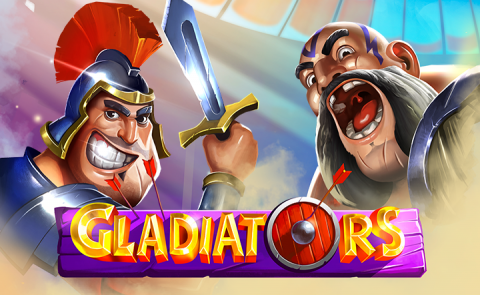



Welcome to a journey through time to explore the fascinating world of gladiators in ancient history. From sand-covered arenas to the thunderous applause of a roaring crowd, the rise and fall of these legendary warriors captured the imaginations of people from all walks of life.
In this article, we'll delve into the world of gladiators, examining their origins, their place in ancient society, and ultimately, their demise. But, what does this have to do with Gambino Slots, Free Spins, and Social Casino? Well, as we explore the world of gladiators, we'll also be looking at how their stories have inspired some of today's most exciting free slots and online casino games. So, whether you're a history buff, a gambler, or just someone looking for an entertaining read, join us on this journey from sand to glory.
Gladiator games first emerged in ancient Rome around 264 BC, during the Roman Republic. These games were originally held as part of funeral rites, where slaves or prisoners of war would fight to the death in honor of their fallen masters. However, as time passed, these games became more and more popular and began to be held for entertainment purposes. As the popularity of the games grew, so too did the demand for gladiators. These warriors were typically slaves, prisoners of war, or criminals who had been sentenced to fight in the arena as punishment. However, some gladiators were also volunteers who saw the games as a way to gain fame and fortune. The first gladiatorial games were held in temporary wooden arenas, but as the popularity of the games grew, permanent stone amphitheaters were built to host them. These arenas could hold tens of thousands of spectators, and the games became a major part of Roman culture.
Gladiators were trained in specialized schools known as ludi. These schools were often owned by wealthy individuals who would purchase and train gladiators for the purpose of selling them to event organizers. The training regimen for gladiators was rigorous and often brutal, as they were required to be in prime physical condition in order to survive in the arena. Gladiators were trained in a variety of fighting styles, including the use of swords, shields, and other weapons. They were also taught how to fight with a variety of armor and were often given specialized helmets that would identify them to the crowd. In addition to physical training, gladiators were also trained in showmanship. They were taught how to enter the arena and engage with the crowd, often performing elaborate routines before the start of a fight.
The life of a gladiator was not an easy one. Gladiators were often slaves or prisoners who had been forced into the arena against their will. They were housed in barracks or prisons near the arena and were often kept in chains or under constant guard. Gladiators were fed a diet of barley and other grains, along with a small amount of meat. This was designed to keep them lean and agile, as excess weight could be a liability in the arena. Despite the hardships they faced, some gladiators were able to gain fame and fortune through their performances in the arena. These gladiators were known as "favorites" and were often given special treatment by event organizers
Gladiators played a significant role in ancient Roman society. They were seen as symbols of strength and courage and were often held up as examples of what it meant to be a true Roman. The gladiatorial games were also used as a way for the ruling class to maintain control over the masses. By providing free entertainment to the people, the ruling class was able to keep them happy and distracted from the political and social issues of the day. In addition to their role in Roman society, gladiators also had a significant impact on the development of Western culture. The stories of gladiators have inspired countless works of art and literature, and their legacy lives on to this day.
The gladiatorial games became increasingly popular during the reign of the Roman emperors. These rulers saw the games as a way to gain favor with the people and to demonstrate their power and wealth. Emperors would often hold massive spectacles in the arena, featuring hundreds of gladiators and wild animals. These events were designed to be grand displays of power and were often used to celebrate military victories or other significant events. However, as the popularity of the games grew, so too did their cost. The cost of procuring gladiators, animals, and other equipment became prohibitively expensive, and many emperors began to cut back on the number of games they held.
The gladiatorial games came to an end in the 5th century AD, with the fall of the Roman Empire. The games had become increasingly unpopular in the later years of the empire, with many people viewing them as barbaric and cruel. In addition, the spread of Christianity throughout the empire played a significant role in the decline of the games. Christian leaders viewed the games as a form of idolatry and worked to have them banned. Despite their eventual demise, the legacy of the gladiators lives on to this day. Their stories have inspired countless works of art, literature, and entertainment, and their place in history is secure.
Gladiators have had a significant impact on popular culture, inspiring countless movies, TV shows, and even video games. From the classic Hollywood epic Spartacus to the hit TV series Gladiator, the stories of these legendary warriors continue to captivate audiences around the world. In addition, the world of gladiators has also inspired some of today's most exciting slot games and online casinos. Games like Blood and Sand and Gladiator's Gold allow players to step into the arena and experience the thrill of gladiatorial combat from the comfort of their own home.
Gladiators have also had a significant impact on the world of art and literature. From the epic poems of Homer to the works of Shakespeare, gladiators have been a popular subject for writers and artists throughout history. In addition, the gladiatorial games have been depicted in countless works of art, from mosaics and frescoes to sculptures and paintings. These works provide a fascinating glimpse into the world of the gladiators and the society in which they lived.
The rise and fall of the gladiators is a story that continues to captivate audiences around the world. From their origins as funeral rites to their place in ancient Roman society, the gladiators were a symbol of strength and courage that continues to inspire us today. Despite their eventual demise, the legacy of the gladiators lives on in popular culture and in the hearts and minds of people around the world. Whether you're a history buff, a gambler, or just someone looking for an entertaining read, the story of the gladiators is one that is well worth exploring.
